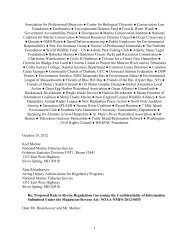About OMB Watch
Chapter III Technology Advisory Committee - OMB Watch
Chapter III Technology Advisory Committee - OMB Watch
- No tags were found...
You also want an ePaper? Increase the reach of your titles
YUMPU automatically turns print PDFs into web optimized ePapers that Google loves.
"Don’t get<br />
caught up<br />
in not<br />
leaving<br />
people<br />
behind<br />
[technologically]<br />
to the<br />
point that<br />
you don’t<br />
develop the<br />
technology<br />
and, then,<br />
everyone is<br />
left out."<br />
These concerns were reflected in the interviews and comments. Questions<br />
asking for other barriers to technology use elicited an outpouring of<br />
responses. Several organizations raised issues of “accessibility to everyone<br />
including people with varying disabilities” and “activists who don’t speak<br />
much English.”<br />
Most comments on this topic (beyond those items mentioned in the survey)<br />
fell into several categories, listed below in order of frequency:<br />
❐ Lack of added utility, need, and perceived value of technology<br />
❐ Lack of staff<br />
❐ Lack of technology among members and constitu ency<br />
❐ Information Overload<br />
❐ Other Concerns (lack of space, system incompatibility, varying skill<br />
of staff)<br />
When the barriers to technology were separated by frequency of e-mail<br />
use, a different dynamic became apparent. Training, education, and technical<br />
suport emerged as the overall most important factors to engage both<br />
those who use e-mail regularly and those who do not use e-mail. Money<br />
and access to new equipment play a more significant role in engaging<br />
those who do not use e-mail at all. Time seems to be a more significant<br />
concern of those who have e-mail access but do not use it daily.<br />
"We eventually<br />
hope to use e-<br />
mail, but<br />
currently don’t<br />
because of<br />
system problems<br />
and<br />
incompetent<br />
systems<br />
personnel.<br />
There are also<br />
issues with<br />
money and a<br />
general fear of<br />
change within<br />
the organization.<br />
... A lot of<br />
(our) affiliates<br />
barely have<br />
money for<br />
phones."<br />
Barriers to Technology by E-Mail Usage<br />
Percentage of respondents indicating each barrier based on frequency of email use.<br />
Barrier<br />
Percentage<br />
of Daily<br />
Email Use<br />
(N = 265)<br />
Percentage<br />
of Weekly<br />
or Periodic<br />
Email Use<br />
(N = 136)<br />
Percentage<br />
of Never<br />
Use/<br />
No Access<br />
to Email<br />
(N = 139)<br />
Difference<br />
between<br />
Irreg. &<br />
Daily Use<br />
Difference<br />
between<br />
No & Daily<br />
Use<br />
Lack of training 33% 51% 50% +18 +17<br />
Technophobia 8% 18% 32% +10 +24<br />
Lack of technical support 29% 42% 43% +13 +14<br />
Lack of money 51% 55% 72% +4 +21<br />
Inadequate outmoded 38% 43% 50% +5 +12<br />
equipment<br />
Lack of organizational 8% 18% 14% +10 +6<br />
commitment<br />
Perception that it would<br />
be too burdensome to 8% 18% 14% +10 +6<br />
change or add systems of<br />
communication<br />
Lack of time 40% 53% 40% +13 0<br />
Staff turnover 3% 3% 9% 0 +6<br />
Lack of success finding 10% 15% 8% +5 -2<br />
useful information<br />
Lack of interest 13% 14% 6% +1 -7<br />
<strong>OMB</strong> <strong>Watch</strong> — May 1997<br />
• 49



